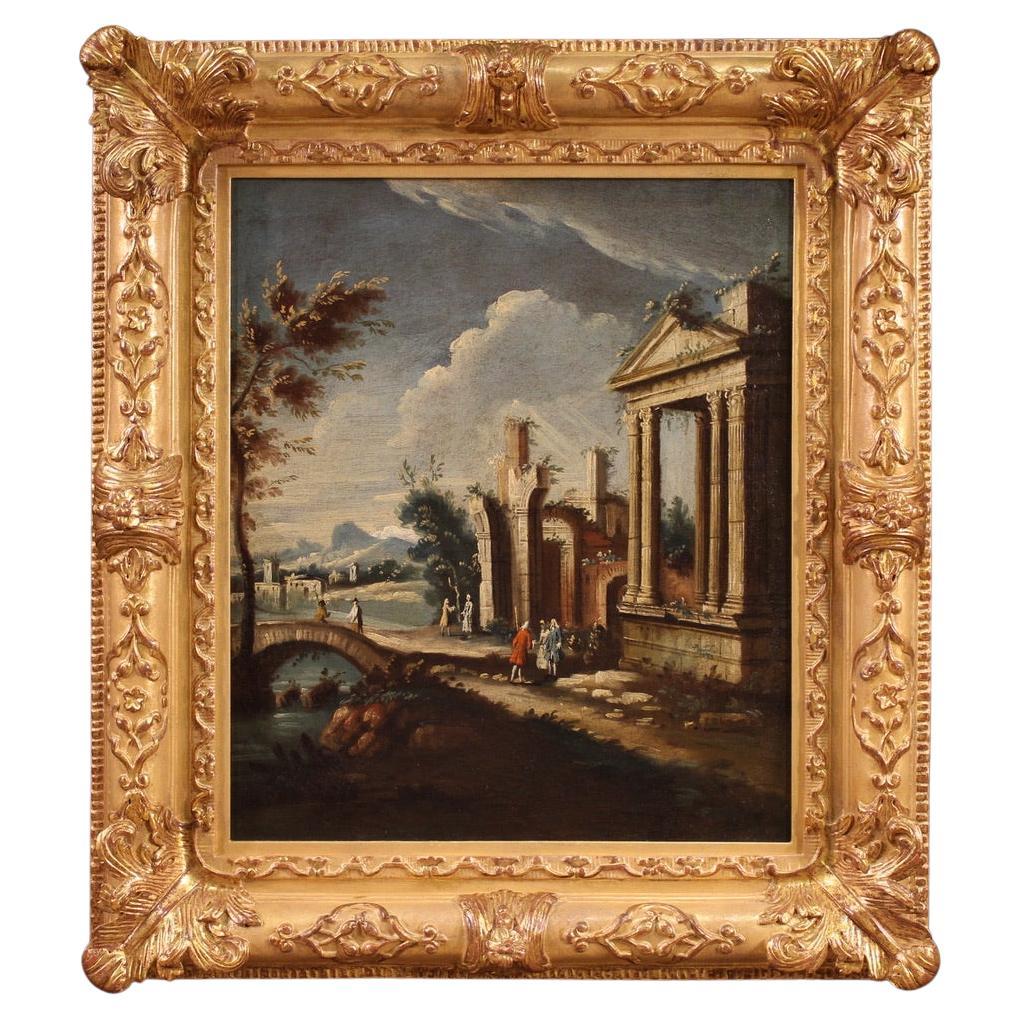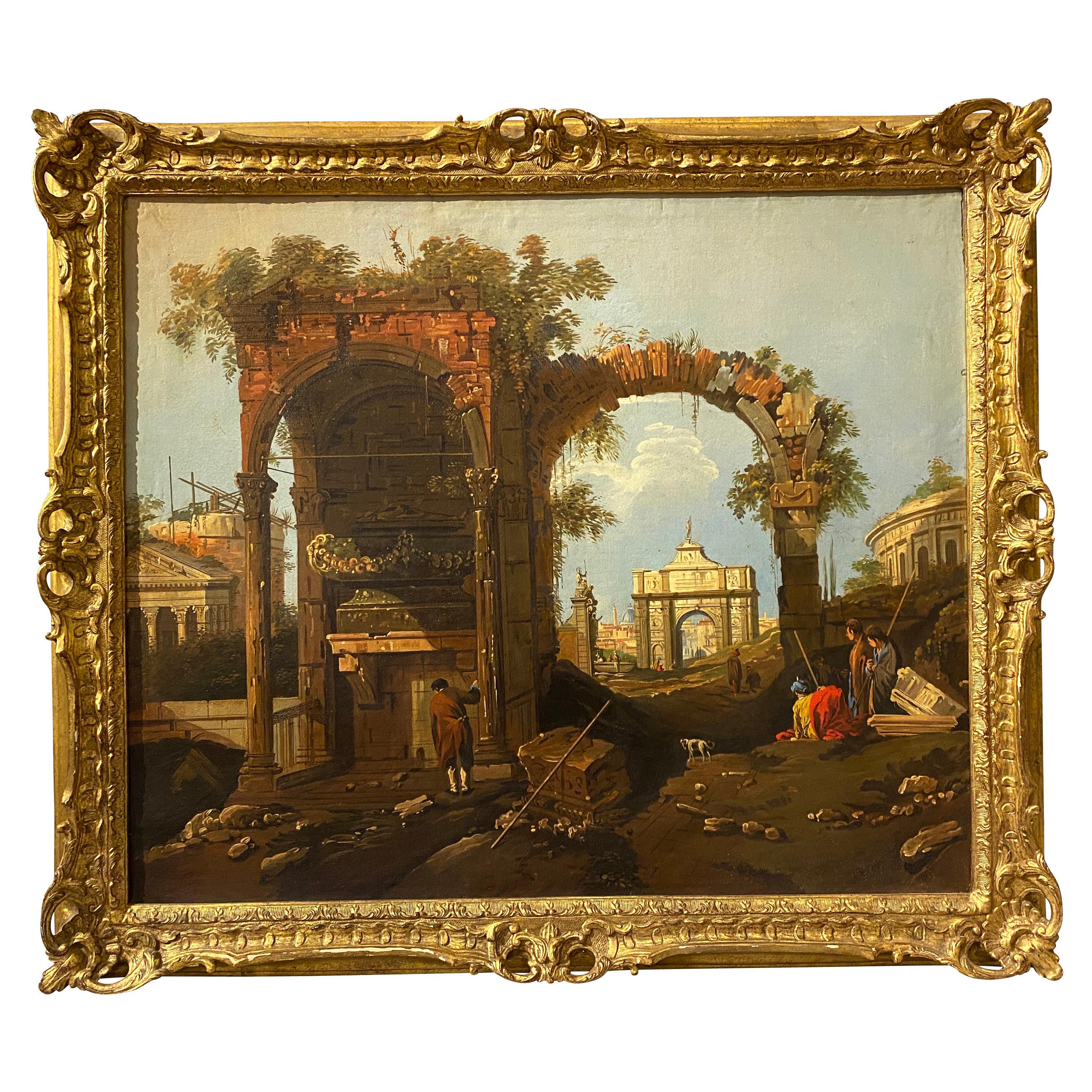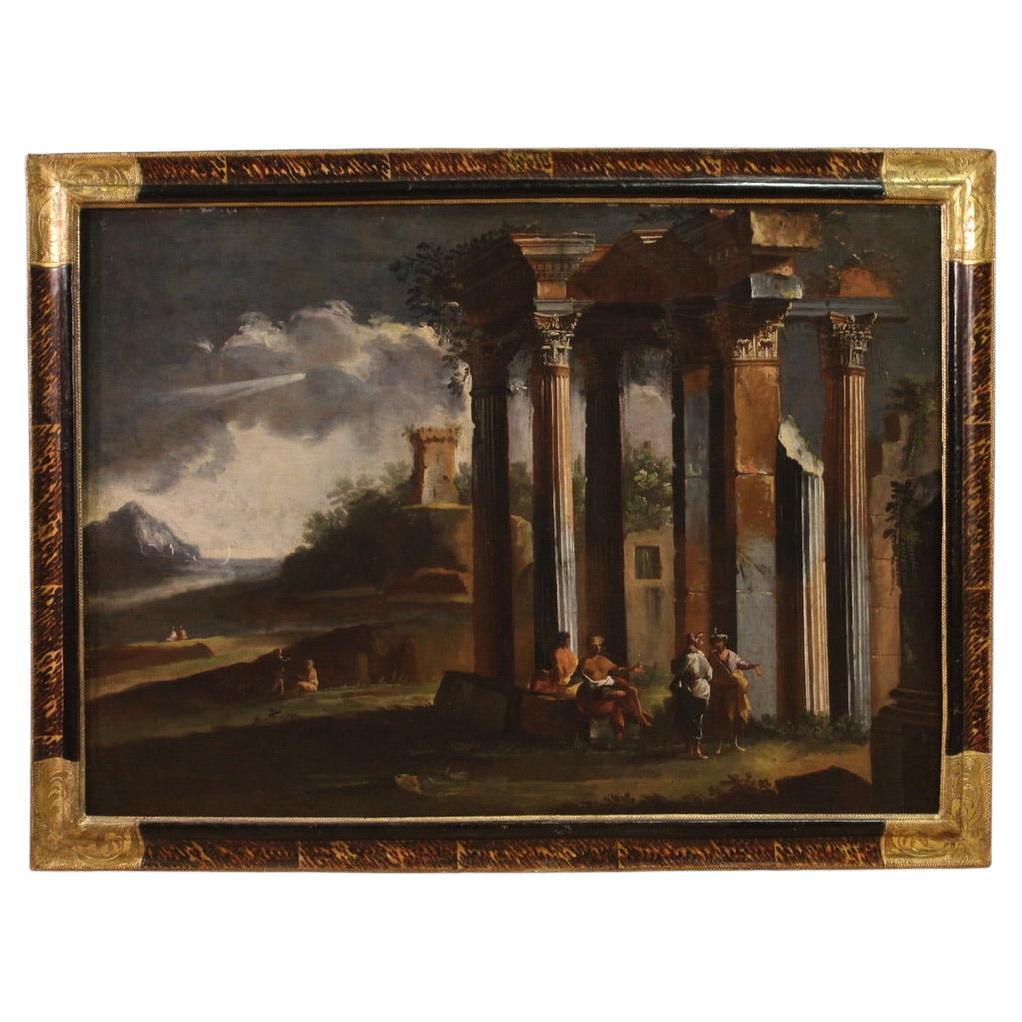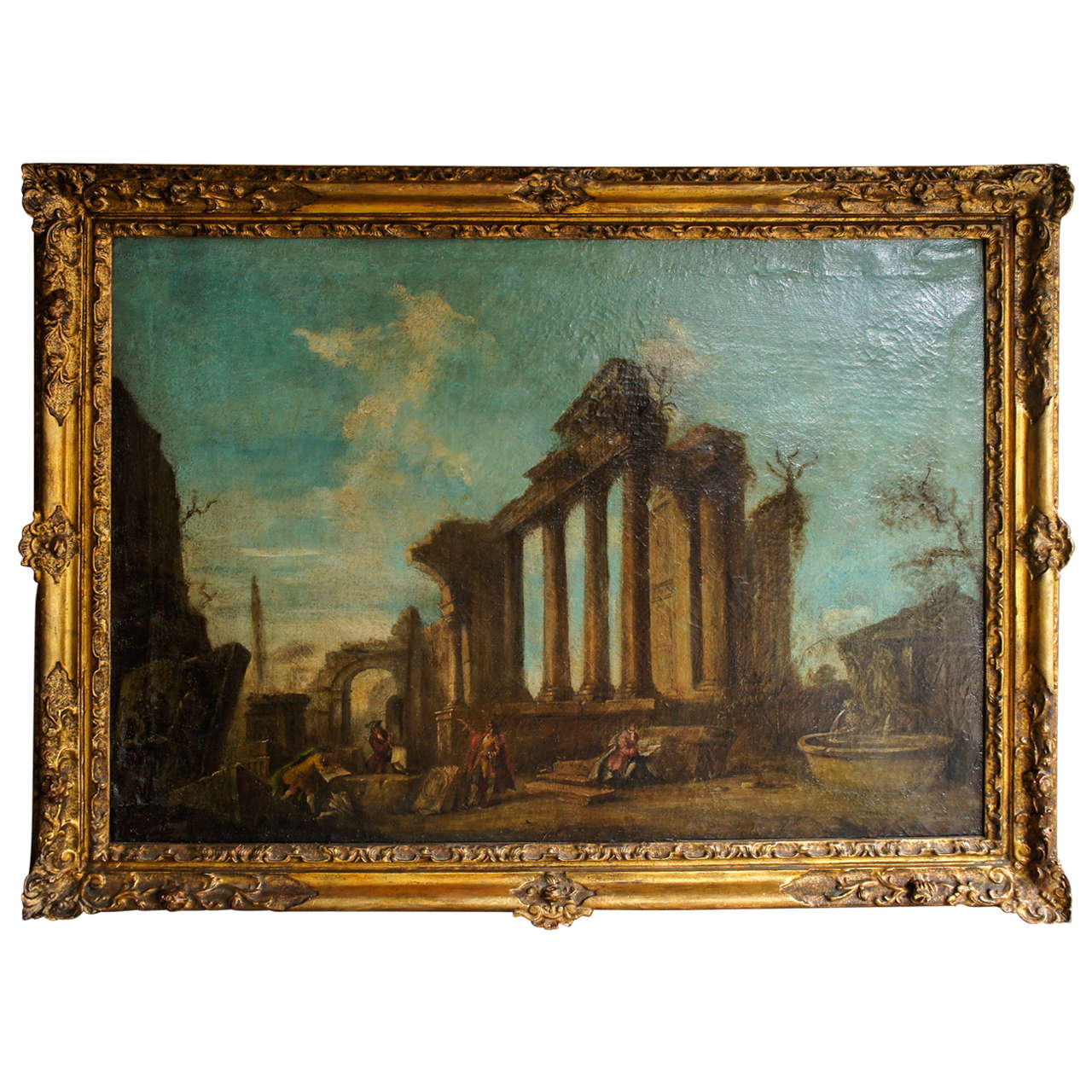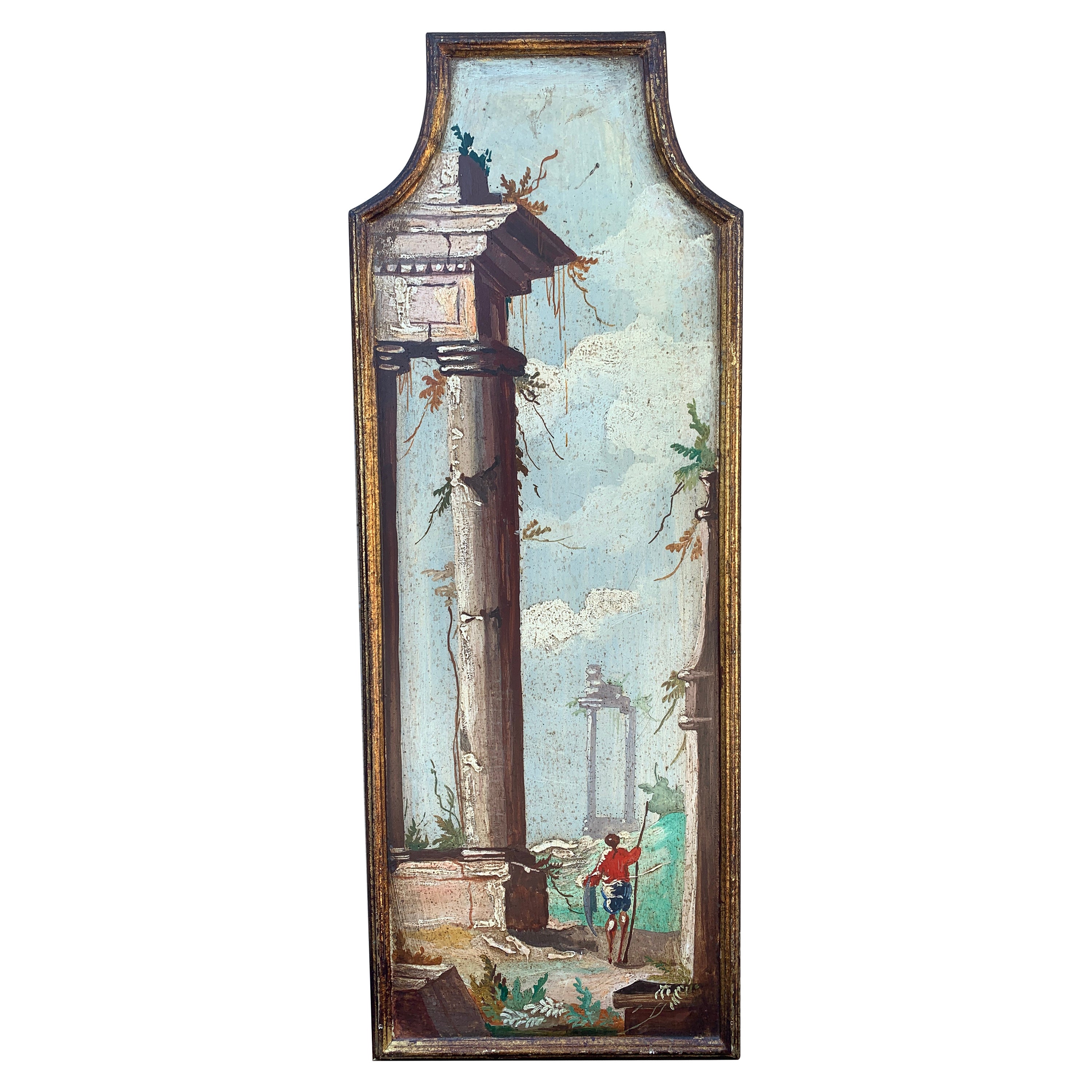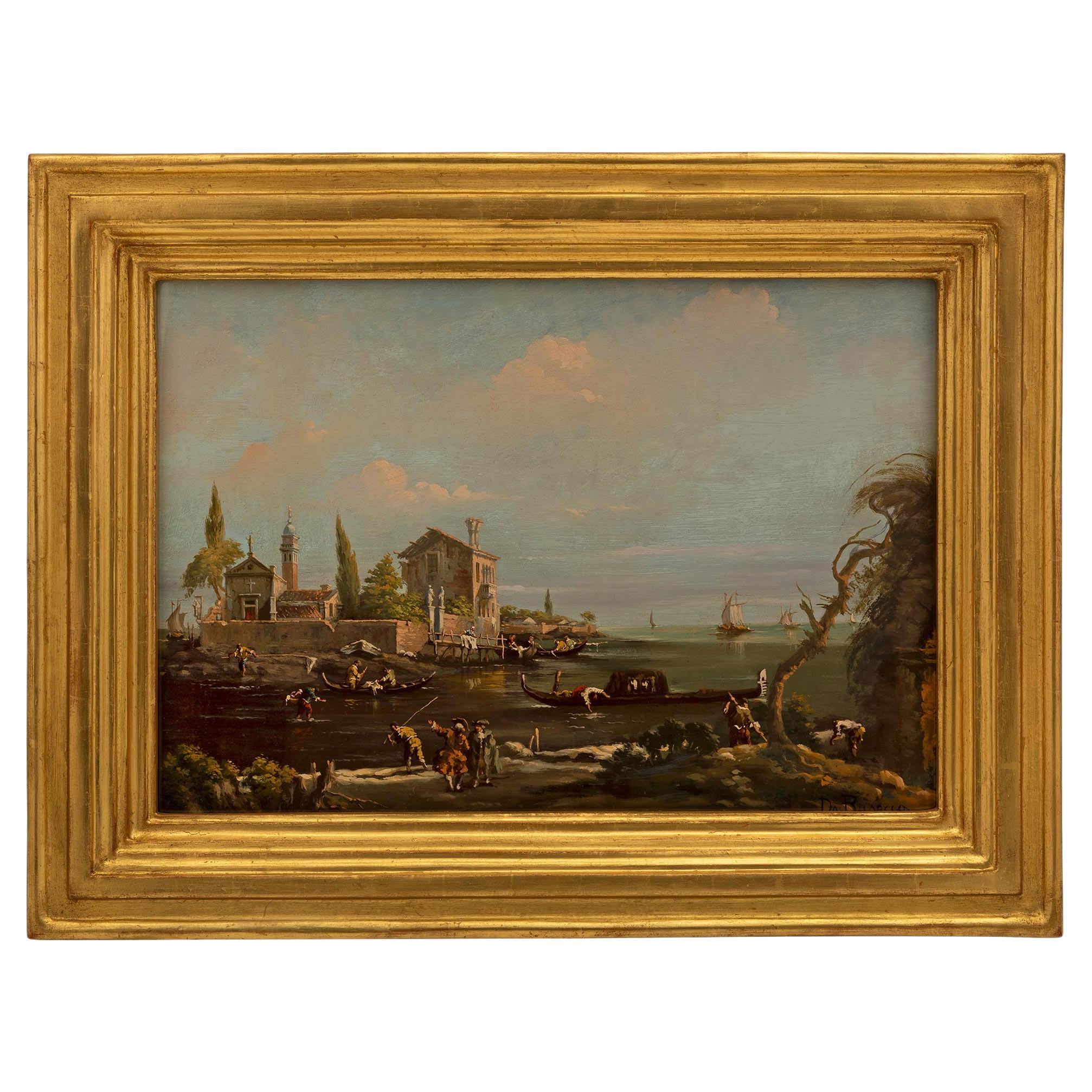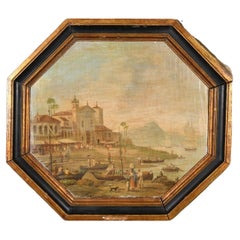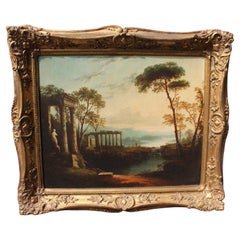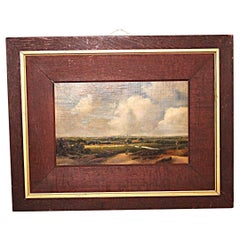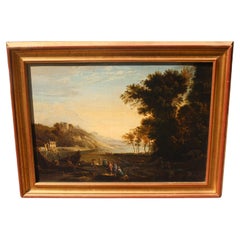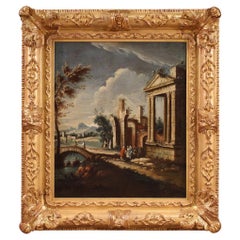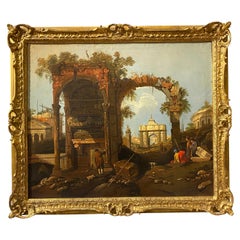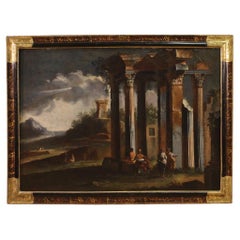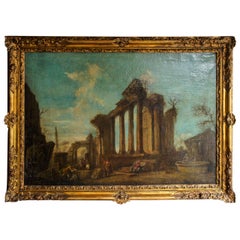Items Similar to Antique Venetian capriccio oil painting
Want more images or videos?
Request additional images or videos from the seller
1 of 13
Antique Venetian capriccio oil painting
$1,677.05
$2,096.3120% Off
£1,240
£1,55020% Off
€1,468.07
€1,835.0920% Off
CA$2,318.66
CA$2,898.3320% Off
A$2,597.29
A$3,246.6220% Off
CHF 1,364.19
CHF 1,705.2420% Off
MX$31,582.24
MX$39,477.8020% Off
NOK 17,275.12
NOK 21,593.9020% Off
SEK 16,398.74
SEK 20,498.4220% Off
DKK 10,956.80
DKK 13,69620% Off
About the Item
Francesco Guardi Venice Oil Painting – Venetian Art in the Manner of Guardi
Exquisite 19th-Century Venetian Oil Painting
Experience the timeless elegance of Venetian art with this remarkable Francesco Guardi Venice oil painting, executed in the manner of the renowned Venetian master. This 19th-century oil painting captures the essence of Guardi’s distinctive style, blending architectural grandeur with atmospheric landscapes.
Titled "Capriccio with an Archway, Figures, and Rustic Houses in the Distance," this stunning piece is a testament to the beauty of Venice, Italy. The artist masterfully combines detailed architecture, dynamic figures, and rustic scenery, evoking nostalgia for the rich artistic traditions of Venetian painting.
This exquisite Francesco Guardi Venice Oil painting is an ideal choice for art collectors, interior decorators, and admirers of Italian Old Masters. Whether you are looking for a statement piece for your home or a significant addition to your fine art collection, this artwork embodies the charm and sophistication of Francesco Guardi.
Key Features of This Francesco Guardi Venice Oil Painting
Artist: Francesco Guardi (manner of)
Date: 19th century
Medium: Oil on panel
Subject: Capriccio with an Archway, Figures, and Rustic Houses
Country of Origin: Venice, Italy
Condition: Some minor paint loss, consistent with age
Style: Venetian Rococo, Capriccio landscape painting
This Venetian oil painting is an exceptional representation of Francesco Guardi’s atmospheric and evocative style, making it a desirable addition to any art collection.
Why Invest in a Francesco Guardi Venice Oil Painting?
A Timeless Masterpiece for Collectors and Art Enthusiasts
Francesco Guardi, one of the last great Venetian view painters of the 18th century, is known for his romantic depictions of Venice. This 19th-century oil painting, inspired by his distinctive approach, encapsulates the grandeur of Venetian capriccio painting, where architectural elements and landscapes are artfully reimagined.
Owning a Francesco Guardi-style Venice oil painting is not only an investment in fine art but also a celebration of Italy’s artistic heritage. This artwork beautifully bridges history and artistry, making it a must-have for enthusiasts of Venetian landscape paintings.
The Perfect Artwork for Your Home or Office
Whether displayed in a luxury home, period property, or modern space, this Venetian masterpiece will captivate viewers with its intricate details and rich color palette. The timeless appeal of Venetian art makes it an elegant focal point in any room.
For those in Sussex and the surrounding areas, this 19th-century oil painting offers a rare opportunity to own a piece of Venetian heritage without traveling to Italy. Art dealers, antique collectors, and interior designers in Sussex seeking Italian Old Master-style paintings will find this artwork an ideal acquisition.
Buy a Venetian Oil Painting – Own a Piece of Italy’s Art History
Collectors and art investors recognize the significance of Francesco Guardi and his Venetian cityscapes. Paintings in his manner continue to be sought after for their evocative atmospheres, intricate compositions, and historical charm.
This Venetian capriccio painting offers a glimpse into the enchanting world of 18th and 19th-century Venice, a city celebrated for its artistic excellence. Don’t miss the opportunity to add this exceptional oil painting to your collection.
- Dimensions:Height: 8.67 in (22 cm)Width: 12.6 in (32 cm)Depth: 1.58 in (4 cm)
- Materials and Techniques:
- Period:
- Date of Manufacture:1910
- Condition:Minor losses. Little paint loss could do with a light clean.
- Seller Location:Seaford, GB
- Reference Number:1stDibs: LU10376244494712
About the Seller
New to 1stDibs
Joined in the past six months.
No Reviews Yet
Vetted Professional Seller
Every seller passes strict standards for authenticity and reliability
Established in 2021
1stDibs seller since 2025
Typical response time: 3 hours
- ShippingRetrieving quote...Shipping from: Seaford, United Kingdom
- Return Policy
Authenticity Guarantee
In the unlikely event there’s an issue with an item’s authenticity, contact us within 1 year for a full refund. DetailsMoney-Back Guarantee
If your item is not as described, is damaged in transit, or does not arrive, contact us within 7 days for a full refund. Details24-Hour Cancellation
You have a 24-hour grace period in which to reconsider your purchase, with no questions asked.Vetted Professional Sellers
Our world-class sellers must adhere to strict standards for service and quality, maintaining the integrity of our listings.Price-Match Guarantee
If you find that a seller listed the same item for a lower price elsewhere, we’ll match it.Trusted Global Delivery
Our best-in-class carrier network provides specialized shipping options worldwide, including custom delivery.More From This Seller
View AllEarly 19th century Capriccio Brazil School Painting
Located in Seaford, GB
Rare Early 19th century Capriccio view of Rio de Janeiro Painting
Probably painted circa 1810 by one of Jean-Baptiste Debret, Italian Students.
Painted on Sailcloth.
Historical Context of Early 19th Century Portuguese Colonial Brazil
1.1 Transition from Colony to Empire
During the early 19th century, Brazil underwent a seismic shift in its political status. Originally a colony under the Portuguese Empire, the arrival of the Portuguese Royal Court in Rio de Janeiro in 1808 rapidly elevated the city’s cultural and political importance. By 1815, Brazil was declared a kingdom united with Portugal, setting the stage for the emergence of the Empire of Brazil in 1822. This period of transformation—often termed the transitional period from colony to empire—fueled a wave of artistic production in cities like Rio de Janeiro.
1.2 European Artistic Influence in Brazil
With the French Artistic Mission in Rio (initiated in 1816) and the presence of various Portuguese and European artists, Brazilian art of the early 1800s began to reflect diverse influences, from neoclassical painting to the early rumblings of romanticism. Painters such as Jean-Baptiste Debret, and Nicolas-Antoine Taunay, and local luminaries like Manuel de Araújo Porto-Alegre contributed to the fine arts tradition in Brazil. Their works featured scenes of local life, portraits of Brazilian society, and imaginative vistas—sometimes referred to as “capriccios,” in which real elements were combined with artistic liberties to create an idealized panorama.
1.3 Rio de Janeiro as Cultural and Political Hub
Rio de Janeiro, often called the Imperial capital after Brazil’s independence, was home to foundational institutions like the Imperial Academy of Fine Arts (Academia Imperial de Belas Artes). Later evolving into the Escola de Belas Artes (School of Fine Arts in Rio), these academies nurtured the talents of emerging painters, who found patronage under the Royal Court and, subsequently, the Imperial Court. The city’s significance was further enhanced by the construction of significant buildings, the modernization of infrastructure, and the mingling of European courtly customs with the traditions of local inhabitants.
. Description of the Octagonal Oil on Canvas: A Capriccio View of Rio de Janeiro
2.1 Composition and Layout
The most striking characteristic of this 19th-century Brazilian art piece is its octagonal shape, a relatively unusual format that draws the viewer’s gaze toward its centre. The composition showcases Rio de Janeiro’s shoreline in the early 1800s, brimming with merchant ships and smaller boats anchored near the shore. On the sand, there is a bustling crowd of local people—men and women carrying food and goods on their heads, loading and unloading boats, and engaging in everyday commerce. The backdrop of soaring mountains suggests Rio’s iconic topography, embodying the landscape that famously defines the city.
2.2 Architectural and Religious Landmarks
On the left side, one can discern the silhouette of a church believed to be Santa Lucia, a significant religious structure in the heart of early 19th-century Rio. This element provides viewers with a tangible reference point, linking the scene to an actual location. However, because this painting is labelled as a “capriccio,” the artist might have taken creative liberties by rearranging or amplifying certain features of the city. The melding of real and idealized elements is characteristic of these imaginative vistas.
2.3 Evoking Daily Life in Colonial Rio
One of the painting’s greatest appeals lies in its portrayal of daily life during the colonial era. Men and women from various backgrounds populate the scene. Some appear to be carrying goods on their heads, a common practice in Brazil that has persisted through different centuries. Others appear to be haggling or trading near small vessels, revealing the commercial pulse of an active port city. This focus on local people, combined with the grandeur of merchant ships, captures the tension and synergy between the every day and the extraordinary—a hallmark of Brazilian colonial painting that balances the grand narratives of empire with the rhythms of ordinary life.
2.4 An Amalgamation of Neoclassical and Romantic Influences
Although academic art in early 19th century Brazil was highly influenced by neoclassicism, the onset of romanticism can be spotted in the emotional portrayal of the sky, the lively palette, and the dramatic emphasis on nature’s beauty (the mountains, in particular). This duality reflects the fine arts tradition in Brazil during the transitional phase when artists were embracing multiple styles. As part of the School of Rio or the Rio de Janeiro school, painters often integrated academic techniques learned from European masters with emerging local subjects and influences.
3. Institutions and Artistic Movements
3.1 Imperial Academy of Fine Arts
Originally known as the Royal School of Sciences, Arts, and Crafts, the Imperial Academy of Fine Arts in Rio de Janeiro was instrumental in shaping 19th-century Brazilian art. Influential artists and teachers from Portugal, France, and other European nations congregated at the Academy, imparting their expertise to native students. As the monarchy consolidated power, the Academy enjoyed royal patronage, leading to the creation of Imperial Academy-style works that combined European academic rigour with Brazilian-themed subject matter.
3.2 Impact of the French Artistic Mission
The French Artistic Mission, which arrived in 1816, played a pivotal role in introducing advanced European artistic techniques, thereby elevating the overall quality of painting in Brazil. Artists like Jean-Baptiste Debret not only documented Brazilian society but also spearheaded the development of a local visual identity that aligned with both academicism and the national context of a blossoming empire. Debret, alongside others such as Nicolas-Antoine Taunay, mentored Brazilian artists, sowing the seeds of what would become the Brazilian academic art movement.
3.3 Religious, Historical, and Landscape Paintings
In addition to everyday scenes and historical compositions, religious iconography remained crucial throughout Portuguese colonial and imperial Brazil. Churches were omnipresent in cityscapes like Rio de Janeiro. Many colonial-era Brazilian portraits...
Category
Antique Early 19th Century Brazilian Spanish Colonial Paintings
Materials
Canvas
$2,921 Sale Price
20% Off
Manner of Claude Lorrain The Goat heard in Arcadian Landscape
By Claude Lorrain
Located in Seaford, GB
An Exquisite Italianate Arcadian Landscape Oil Painting
This late 18th-century Italianate classical landscape oil painting beautifull...
Category
Antique Late 18th Century European Baroque Paintings
Materials
Canvas, Paint
Dutch 19th century Landscape Painting
By Andreas Schelfhout
Located in Seaford, GB
This charming oil-on-paper painting captures a serene landscape near Haarlem, evocative of Andreas Schelfhout's masterful Dutch Romantic style. The work features a quintessentially D...
Category
Antique Late 19th Century Dutch Late Victorian Paintings
Materials
Paint, Paper
Manner of Claude Lorrain Merchants on the banks of the river po
By (after) Claude Lorrain (Claude Gellée)
Located in Seaford, GB
Italianate landscape, Manner of Claude Lorrain
Very good Quality oil on relined canvas in the Manner of Claude Lorrain, cargo ships on the banks of the river Po Italy.
📜 Provenance – Italianate Landscape after Claude Lorrain, England or Italy, circa late 18th–early 19th century
This finely executed oil on canvas is an accomplished historic copy after Claude Lorrain’s celebrated Italianate river landscapes, specifically related to his Landscape with Merchants (c. 1630s), held at the National Gallery of Art, Washington, D.C. The composition also bears a close resemblance to the 1769 engraving by Boydell and James Mason, after a painting once in the distinguished collection of Robert Trevor, 4th Baron Trevor, later 1st Viscount Hampden.
The scene features cargo ships along the tranquil banks of the River Po, enveloped in the soft, atmospheric light for which Claude Lorrain (1600–1682) is universally revered. Executed in the idiom of the Grand Tour period, the painting exemplifies the classical Arcadian themes sought by aristocratic collectors travelling through Italy in the 18th and early 19th centuries.
This work is a particularly elegant example of the period's taste for Claudean compositions, balancing architectural elements with expansive vistas and golden, diffused light. The canvas has been professionally relined and restored, housed in a contemporary frame that complements the work’s scale and palette. Minor craquelure and darkening to areas of the blue and green pigments remain consistent with age, enhancing its historic charm.
Ideal for integration into neoclassical, traditional, or transitional interiors, this work represents an opportunity to acquire a piece of decorative art with a strong visual lineage and academic relevance — a testament to Lorrain’s enduring influence across centuries of landscape painting.
Very similar to the Landscape with Merchants in the National Gallery of Art, Washington, D.C.
Our version could be after the engraving by Boydell and James Mason on 1st January 1769.
Interestingly, the source painting for the painting was once in the collection of Robert Trevor, 4th Baron Trevor (from 1764), and subsequently (from 1776) 1st Viscount Hampden.
18th-Century Italian Landscape in the Manner of Claude Lorrain
This exquisite 18th-century Italian Landscape in the manner of Claude Lorrain captures the essence of Italian Baroque landscape painting, showcasing the serene beauty and harmony of the classical countryside. Drawing inspiration from the Golden Age landscape painting, it reflects the elegance and detail characteristic of Claude Lorrain-style artwork, featuring sweeping vistas, balanced compositions, and an idealised landscape scene that exudes timeless charm.
A Classical Italian Countryside Painting...
Category
Antique 18th Century British Baroque Paintings
Materials
Canvas
Exquisite 19th Century English Still Life of wild flowers– Oil on Wood Panel
Located in Seaford, GB
A captivating and finely executed 19th-century English still life painting, rendered in oil on wood panel, depicting an abundant bouquet of mixed flowers in a terracotta urn. This hi...
Category
Antique 19th Century English High Victorian Paintings
Materials
Paint
18th century Fine Italian Grand Tour gouache of Palladian Villa
Located in Seaford, GB
This fine 18th-century gouache on paper is a quintessential example of Grand Tour artistry, depicting an Italian Palladian villa rendered with architectural precision and classical r...
Category
Antique Mid-18th Century Italian Grand Tour Paintings
Materials
Paper
You May Also Like
18th Century Oil on Canvas Venetian Architectural Capriccio Landscape Painting
Located in Vicoforte, Piedmont
Refined Italian landscape from the second half of the 18th century. Oil painting on canvas depicting a splendid view with ancient ruins and figures in Venetian dress, of remarkable p...
Category
Antique 1760s Italian Paintings
Materials
Canvas
Framed Italian Capriccio Oil on Canvas
Located in Essex, MA
Well painted with scene of ancient ruins. In a carved gilt wood frame.
Category
Antique Late 19th Century Italian Paintings
Materials
Canvas
18th Century Oil on Canvas Venetian Architectural Capriccio Landscape Painting
Located in Vicoforte, Piedmont
Venetian school of the mid-18th century. Oil on canvas painting depicting an invented landscape composition of remarkable pictorial quality. On the right is a ruined building, probab...
Category
Antique 1750s Italian Paintings
Materials
Canvas
19th Century Italian Oil Painting in the Manner of Antonio Panini
Located in Hudson, NY
This fine old painting is a typical pastiche of the kind popular throughout Italy and the world in the 17th, 18th and 19th centuries. The most commonly associated artist who really m...
Category
Antique 19th Century Italian Baroque Revival Paintings
Materials
Canvas, Wood
Antique Grand Tour Italian Capriccio Framed Oil on Board Painting of a Landscape
Located in Elkhart, IN
A gorgeous Grand Tour or Neoclassical style framed oil painting of an Italian Capriccio landscape with ruins
Italy, Late 19th Century
Oil on board, gilt frame
Measures: 10.25"W x ...
Category
Antique Late 19th Century Italian Grand Tour Paintings
Materials
Wood, Paint
$1,400 Sale Price
20% Off
Italian 19th Century Oil on Canvas Painting
Located in West Palm Beach, FL
A beautiful Italian 19th century oil on canvas painting. The painting depicts a beautiful Italian scene of personages going about their day with charming boats and a house on the wat...
Category
Antique 19th Century Italian Paintings
Materials
Canvas, Giltwood
More Ways To Browse
Italian Rococo Painting
Antique Yard Long
Brass Music Box
Bronze Foo Lions
Byobu Gold Leaf
Camphor Table
Car Radiators
Caste Furniture
Catalan Spanish Baroque
Ceramic And Fiber Wall Sculpture
Chevron Wood Cabinet
Chinese Export Silver Tea Set
Chinese Lattice Panel
Chinese Pottery Statue
Coffee Pot Enamel
Commode Desk Antique
Cork Top Dining Table
Crystal Bowl And Pedestal
